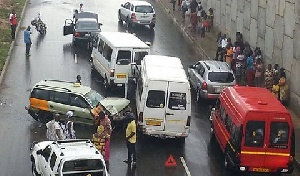 Road accidents have become a worrying trend for Ghanaians more especially now
Road accidents have become a worrying trend for Ghanaians more especially now
hana ranks as one of the most accident-prone countries in the world. This unenviable accolade has been with us for some time now and despite our best efforts, the situation does not seem to abate.
What is worrying is that the more our roads improve, the more the accident rate escalates. So now, after we have invested huge amounts of money to construct roads, the next thing is to make all manner of speed checks to slow down vehicles.
In most cases, such efforts amount to little apart from discomfort to road users and damage to shock absorbers. It is also obvious that the architects of these speed humps do not factor the type of vehicles which ply the roads. Looks like it is now a crime if you cannot ride one of Yaanom’s favourite V8. You should see me trying to negotiate the speed hump at Moree Junction in my Mini Cooper to appreciate this point.
In this potpourri of causal factors of accidents, the driver is always singled out for blame and rightly so. Being the one controlling the machine, it is only reasonable that he exhibits utmost care and responsibility knowing that the souls of his passengers are in his hands. Other factors that come into play include:
Nature of our roads
The architecture of most of our roads defy common sense. For instance, a stretch of less than 20 kilometres on the Cape Coast-Accra highway boasts of 22 sharp curves. Is it a formula one route or a highway? Looks like all we do is to pour bitumen on hunters’ trails! The Cape Coast-Takoradi and Techiman-Sunyani are a few of such roads.
State of vehicles
Try travelling by night and you will be amazed at the number of vehicles with faulty or half-lights. Most trucks are also overloaded and this affects their stability and so the least thing and they are in the bush. As for minor faults like faulty brakes and faulty wipers, the least said about them the better.
The poor driver
The poor driver has a lot on his hands to even think straight as he fends for a wide category of dependents. From spare parts dealers, car owners, mechanics, vulcanisers, Driver and Vehicle Licensing Authority (DVLA ) officials and their ‘goro boys’, windshield cleaners, car washers,’bookmen’, metro guards; the gentlemen in white and their cousins in black to beggars at traffic lights. With such a wide array of mouths to feed, where is the peace for the poor driver to do his work?
The pedestrian factor
One critical factor in the high rate of accidents which we seem to be glossing over is the role of pedestrians. A driver can be responsible and careful but if pedestrians are reckless and not conscious of their environment, accidents are bound to occur.On several occasions, it has taken Divine intervention to avoid hitting an absent-minded or drunk pedestrian. In fact, the average Ghanaian does not know how to cross a road safely.
This is made worse when people cannot interpret traffic indicators. How many times has one not indicated turning to a side road and yet people will be walking to cross towards the same direction. The lack of street lights and our love for black fabrics on weekends does not help either. We do not even know how to use the zebra crossing and tend to think that you can outrun a moving vehicle to cross a road.
In fact, Ghana may be one of the few places where pedestrians run to cross roads and profusely thank drivers if they do as little as to reduce speed for them to cross. Also, it is not every part of a road that is suitable for a pedestrian crossing. Why in God’s name would someone attempt to cross a road in the middle of a roundabout and expose themselves to vehicles coming from all directions of the road.
The way forward
There is the urgent need to embark on a nation-wide campaign to educate ourselves on the basics of safe road use. Practical lessons are critical. Using animations and other forms of media may help. This must complement education on safe and defensive driving. Physical interventions like footbridges, traffic lights and zebra crossings should still be pursued.
No driver who is not on unprescribed high dose of tramadol will dream of killing a pedestrian. The physiological trauma alone is enough to give one a nightmare for a lifetime. The way to go is to involve all road users in this fight.
The writer is the acting Director, Directorate of Public Affairs, University of Cape Coast.